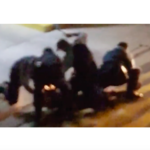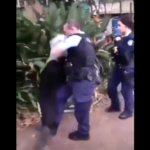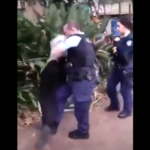Teenage Girls Charged with Detaining, Taunting and Brutalising Peer

Three girls aged 12, 13 and 14 have been charged with serious offences over an alleged brutal and prolonged assault of a 13-year old girl.
The four girls, who are reported have been friends, were at a sleepover in Tewantin on the Sunshine Coast in Queensland when three of them allegedly ganged up on the other, assaulting, taunting, stomping on her head and cutting her with a knife over a several hours.
The victim was allegedly prevented from leaving the premises, and the incident was filmed and then posted to social media.
The charges
Each of the alleged assailants have been charged with assault occasioning bodily harm, deprivation of liberty and entering dwelling and committing an indictable offence.
Police say that more charges could be forthcoming.
The 14 year old is in custody, and will appear before the Maroochydore Children’s Court in April.
It’s reported that another video of one of the alleged perpetrators has been posted online, in which the girl boasts, “going viral thanks guys love ya”.
What’s baffling is that the girls appeared to be able to conduct the assault over a number of hours, without parental intervention.
In Queensland, the legal age children can be left at home without supervision is 12 years.
Seeking notoriety
Police have urged people to stop sharing the video on social media, as doing so will give the assailants exactly whatthey crave – fame and notoriety – and could result in ‘copycat’ offences.
In Queensland, assault occasioning bodily harm is an offence with a maximum penalty for five years. In circumstances of aggravation, the maximum penalty is imprisonment for 7 years.
Deprivation of liberty has a maximum penalty of 3 years.
Entering dwelling and committing an indictable offence attracting a penalty of 10 years behind bars. In circumstances of aggravation the penalty increases to 14 years.
A ‘specially aggravated’ whereby the alleged offender wounds or maliciously inflicts grievous bodily harm on any person and or is armed with a dangerous weapon has a maximum penalty of imprisonment for 20 years.
Vigilantes
Police are also concerned that vigilantes are ready to take matters into their own hands.
Since news of the incident started circulating on social media, the three suspects have had their addresses published online, and there have been threats to the properties they live in, as well as to them individually.
In recent months, youth offending has spiked in Queensland, and vigilantes are on the rise, which is also causing a major problem for police.
Experts say that when it comes to juvenile crime, adults feel like it might be “easier” to take on juveniles, but that only perpetuates the danger and often exacerbates the problem.
Social media has a way of whipping communities into a frenzy over very quickly – group chatter focused on the problem can make people feel like they want to seek immediate revenge or retribution rather than waiting for the justice system to run its course.
Equally, social media has a way of making heroes out of people who actually do something to stand up for themselves or their neighbourhood.
People need to understand that if they take matters into their own hands, they run the risk of being harmed themselves, or arrested and charged if they harm someone else.
In response to some violent youth crimes in recent months, the Palaszczuk Government announced tough new juvenile justice initiatives in December last year including an investment in new detention centres, increased funds for police, harsher maximum sentences for car thieves, and reduced avenues for bail.
Under the plan, youths who boast about their crimes on social media will face harsher sentences. While ‘selfies’ and videos can be used as evidence, there’s also increasing pressure on the Federal Government to change cyber safety legislation to cover this specifically, even though the current laws include responsibilities for the removal of material which “promotes, instructs or incites in matters of crime or violence” .
The offence of Assault Occasioning Actual Bodily Harm in NSW
In New South Wales, section 59 of the Crimes Act 1900 prescribes a maximum penalty of 5 years in prison for the offence of Assault Occasioning Actual Bodily Harm, or AOABH.
To establish an AOABH, the prosecution must prove beyond reasonable doubt that:
- The defendant committed an act of violence towards another person, and
- The act caused injuries amounting to actual bodily harm.
The maximum penalty increases to 7 years in prison where the offence is committed with another or other persons.
What is actual bodily harm?
‘Actual bodily harm’ (ABH) is that which is more than ‘transient or trifling’; in other words, more than slight harm – such as minor redness or passing scratches – which quickly subside; Donovan [1934] 2 KB 498.
Examples of ABH may include bruises or lasting scratches or swelling; McIntyre v Regina (2009) 198 A Crim R 549 at para [44].
Transient emotions, feelings or states of mind do not amount to ABH unless there is evidence of very serious psychological harm, or psychiatric injury; Li v R [2005] NSWCCA 442 at [45]; Chan Fook (1994) 1 WLR 689.
What are the defences?
Legal defences to the charge of assault occasioning actual bodily harm include self defence, duress, necessity and automatism.
In the event evidence of a legal defence is raised, the onus then shifts to the prosecution to prove beyond reasonable doubt that the offence does not apply.
The defendant must be acquitted – in other words, found not guilty – if the prosecution is unable to do this.







